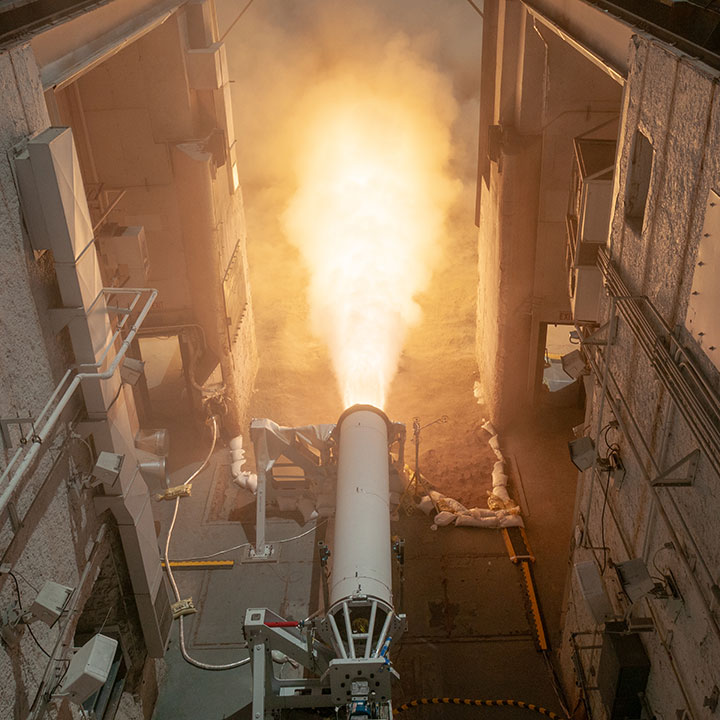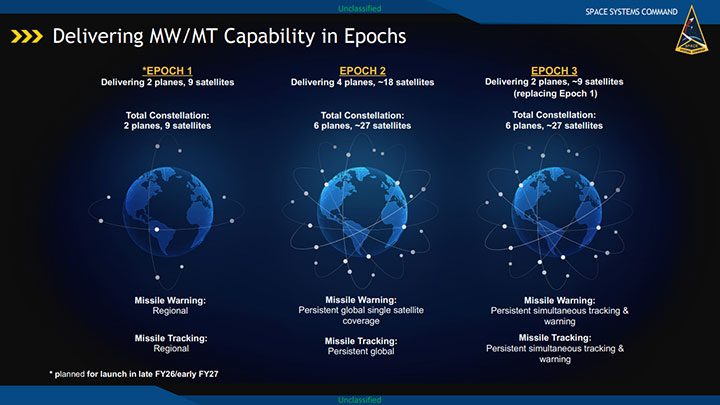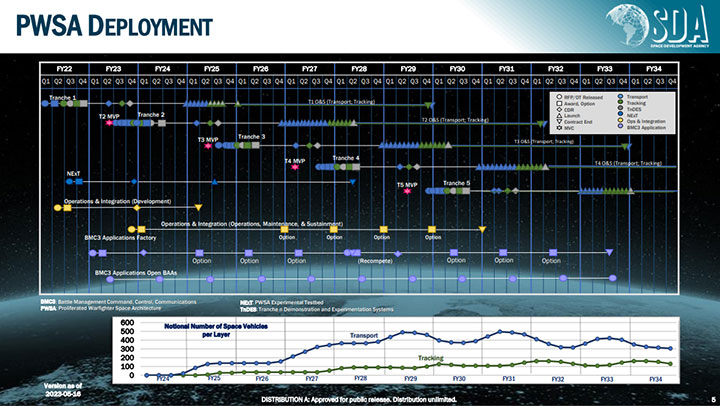 In this May 27, 2021 photo, U.S. Navy Strategic Systems Programs conducts a successful test of the First Stage Solid Rocket Motor as part of the development of its offensive hypersonic strike capability. (Source: U.S. Navy)
In this May 27, 2021 photo, U.S. Navy Strategic Systems Programs conducts a successful test of the First Stage Solid Rocket Motor as part of the development of its offensive hypersonic strike capability. (Source: U.S. Navy)
ALEXANDRIA, Va. — The era of hypersonic weapons has arrived and with it has come an urgent push to upgrade space-based missile warning/missile tracking (MW/MT) infrastructure to meet the new threat.
“If you’re not frightened about these hypersonic glide vehicles, you should be,” said Col. Heather Bogstie, head of U.S. Space Systems Command’s Resilient Missile Warning Tracking Defense Acquisition Delta at the MilSat symposium in Mountain View, Calif.
Bogstie is overseeing the development of a constellation of medium Earth orbit satellites that will form a critical piece of an upgraded multi-orbit, persistent MW/MT architecture.
The days of only having to track the relatively predictable ballistic trajectories are gone. Hypersonics, and hypersonic glide vehicles (HGVs) in particular, add an element of unpredictability. With speeds of Mach 5 and above, an HGV is dimmer and can travel within the hard-to-track upper reaches of the atmosphere. Its trajectory can be adjusted along the flight path to shorten or extend its range, creating significant uncertainty about its intended target.
“You’re not able to track HGVs utilizing what is currently on orbit,” Tim Ryan, Senior Resident Fellow for Space Studies at the Mitchell Institute’s Spacepower Advantage Center of Excellence told Constellations. “The speeds are too fast. The profile is not able to be tracked and it can maneuver as it descends.”
Today’s Cold War-era Defense Support Program (DSP) and Space-Based Infrared System (SBIRS) continue to be effective and critical pieces of MW/MT, but the GEO-based systems were simply not designed for the growing threat environment.
According to the most recent Pentagon report on Chinese military and security developments, China deployed its first HGV-armed medium-range ballistic missile in 2020 and conducted a fractional orbital launch in 2021. In 2022, the PLA Navy launched a hypersonic missile designed to defeat aircraft carriers. Russia reportedly put a nuclear-capable Avangard HGV into service in 2019 and reports have suggested it has used hypersonic weapons against Ukraine. Meanwhile, Iran’s rapidly evolving missile capabilities continue to be a strategic concern for the United States and its allies.
A More Capable Sensor Network
The ability to counter the emerging missile threat has been a driving force for the U.S. Space Force to develop an extended network of sensors in MEO and LEO within a timeframe of the next five years. When complete, there will be approximately 27 satellites across six orbital planes in MEO and roughly 100 LEO tracking satellites. The GEO system was completed earlier this year when Lockheed’s SBIRS GEO-6 entered service.
 A timeline for missile warning/missile tracking capabilities in MEO presented at the MilSat Symposium, Oct. 19, 2023 (Source: Space Systems Command)
A timeline for missile warning/missile tracking capabilities in MEO presented at the MilSat Symposium, Oct. 19, 2023 (Source: Space Systems Command)
The new architecture will not only incorporate improved infrared sensor technologies, but it will leverage the advantages of MEO and LEO orbits and standardized optical crosslinks to move data between orbital planes and orbits and get information to the warfighter or decision-makers faster.
“Low latency is critical to enabling rapid reaction times and accurate target data throughout the course of flight,” said Bogstie. While existing systems in geosynchronous orbit enable operators to observe large swaths of territory, the completed near-Earth constellations will offer a heightened level of persistence. The LEO-MEO network will be designed to hand off custody among satellites and observe the threat from different orbits. That will ultimately support the ability to track dimmer, faster, less predictable targets and react with fire control solutions, when appropriate.
AI and Automation for Missile Warning
In building out the MW/MT architecture, there has been a specific focus on integrating capabilities for intelligent constellation mission management, onboard processing and highly capable ground systems. “We need integrated software and artificial intelligence to effectively manage this evolving, heterogeneous constellation of network sensors, data correlation and fusion,” Bogstie explained. “We need world-class algorithms to correlate and fuse warning and tracking data from hundreds of spacecraft and ground sensors.”
Additionally, the network will rely on “flight-qualified onboard processing systems” to process terabytes of raw data into missile tracks with reduced latency. Similar capabilities will be incorporated into the LEO tracking layer as part of the Proliferated Warfighter Space Architecture, being overseen by the Space Development Agency (SDA).
Bogstie noted that SSC is continuing to assess how much automation can be built into the system. It is widely acknowledged that as the sources and complexity of MW/MT data grow, there will be a need for increased automation, data fusion and artificial intelligence solutions. Naturally, this raises questions, particularly when considering missions, like strategic missile warning, where the margin for error is almost non-existent and the consequences of a false alarm are potentially catastrophic.
“When you start to get into the AI/ML realm…first and foremost, what has to be established is that the data is trusted, it has to be exercised, it has to be shown to the human, whether that’s a human in or on the loop,” said Ryan. Human involvement will almost certainly remain the norm for the foreseeable future of MW/MT, he continued. “But you have to be able to get away from a human collecting the data that’s coming down and processing it. Because when you’re talking about a hypersonic glide vehicle and threats like that, you don’t have [time]. … By the time we figure out what it is, it’s too late.”
SDA and SSC’s Aggressive Development Timelines
The current timeline for building out the MW/MT architecture seeks to move at the speed of the threat. SSC is following SDA’s approach of 2-3-year spiral development cycles. In the case of SSC’s MEO satellites, each development cycle is called an Epoch. For SDA, each cycle is a Tranche.
 A deployment timeline for the Proliferated Warfighter Space Architecture in LEO presented at the MilSat Symposium, Oct. 19, 2023. (Source: Space Development Agency)
A deployment timeline for the Proliferated Warfighter Space Architecture in LEO presented at the MilSat Symposium, Oct. 19, 2023. (Source: Space Development Agency)
To date, SDA has proven its ability to get from “order to orbit” in 30 months, disrupting the DoD culture of 10-year technology development cycles. Whether SDA and SSC will be able to maintain their aggressive pace is yet to be seen.
“There are two ‘enemies’ to the capability being able to stay on a 2-3-year cycle,” Ryan warned. “The bureaucracy inside the Pentagon trying to slow it down and Congress passing continuing resolutions or not passing budget lines to keep up with them.” If those adverse factors are managed, Ryan said he is confident the agencies and industry can maintain the pace and achieve operational MW/MT capabilities within current timelines.
According to SSC, the first Epoch of MEO satellites is scheduled for launch in late 2026 and will deliver initial regional MW/MT capabilities. Already, three vendors have been selected to produce nine satellites across two orbital planes for Epoch 1—Raytheon, Millennium Space Systems and L3 Harris. SSC plans to release a draft request for proposals for Epoch 2 in early 2024, which will include another 18 satellites to achieve persistent global single satellite coverage.
In the near term, SSC is focused on fielding multiple ground relay stations around the globe, such as Northrop Grumman’s Pacific-based Relay Ground Station-Asia (RGS-A), which recently completed a critical design review. This ground architecture will comprise the Future Operationally Resilient Ground Evolution (FORGE), which will be designed to support existing and future missile warning satellites and constellations. SSC aims to have a ground system “fully in place” one year before it launches its first Epoch of tracking satellites.
SDA’s deployment of MW/MT capabilities has already begun with four Tranche 0 tracking satellites as part of the Proliferated Warfighter Space Architecture in LEO. Two of those satellites began transmitting images back in June. Another four Tranche 0 tracking satellites are scheduled for launch by early 2024 and will be used for demonstration and “warfighter immersion,” according to SDA Director Derek Tournear.
Currently, the agency is on track to have an initial warfighting capability in Tranche 1 by the end of 2025, including 126 transport satellites and 35 wide field of view tracking satellites in LEO—all outfitted with optical crosslinks.
SDA has begun awarding contracts for Tranche 2 transport capabilities and it released a tracking layer solicitation in September. Looking ahead, Tournear explained “the beauty of the spiral development program” is the ability to adapt new technologies as they become available. He admitted he does not know what will be on Tranche 3 specifically but “it’s most likely going to be new capabilities.” Tranche 3 is scheduled for launch by 2028 with RFPs expected by mid-2025.
Explore More:
Podcast: Spiral Development, Technology Readiness Levels and Being a Constructive Disruptor
Inter-Satellite Links Are Making Space Networks a Reality
Industry Offers Feedback on SSC’s Commercial Space Reserve Framework
